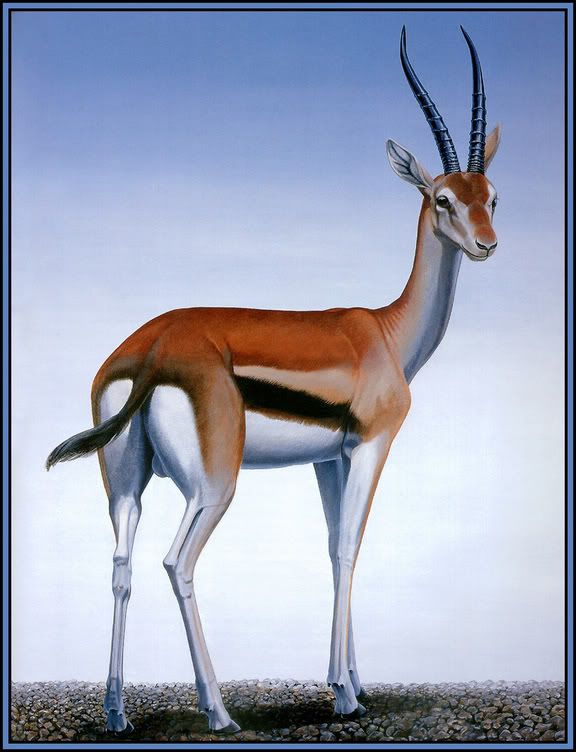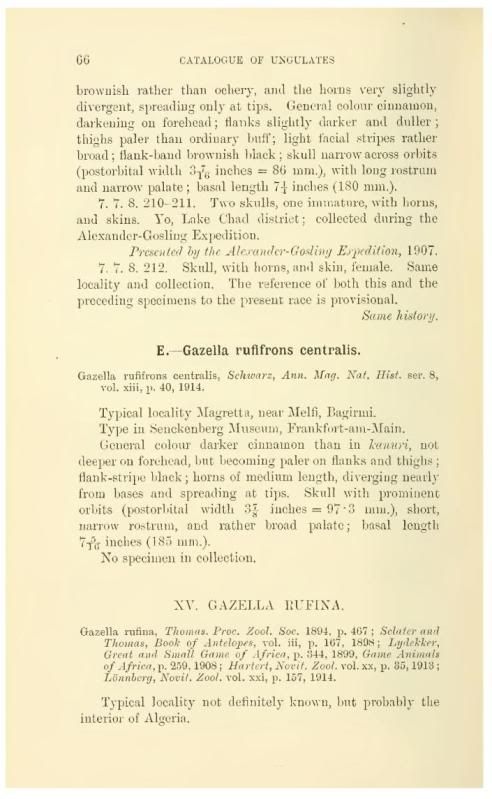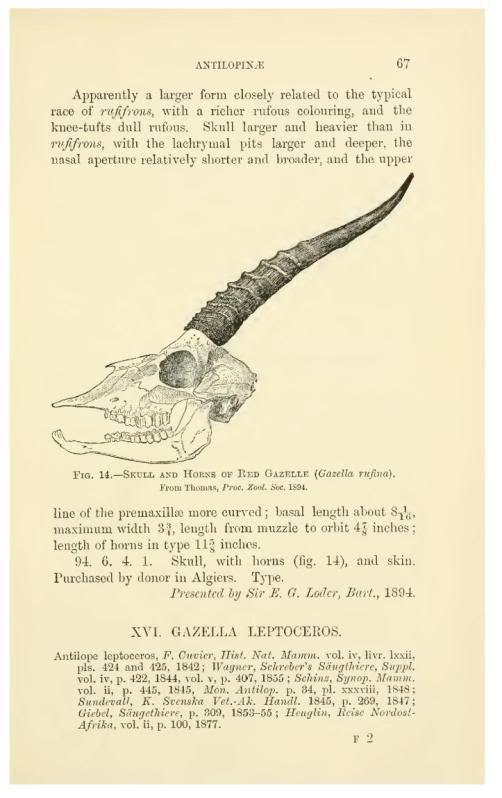|
|
Post by Melanie on Jun 5, 2005 6:53:40 GMT
It was a dark-reddish forest dweller. About 5 ft long and with thick horns a foot in length. It has lived in the Atlas Mountains in Algeria and Morocco. The last specimen where probably shot in 1894 but according to other sources some gazelles were still alive in the Oran-Morocco Border Country in 1925. Also known as Algerian Gazelle or Rufous Gazelle (Gazella rufina). Three museums specimens are left.
|
|
|
|
Post by another specialist on Jun 5, 2005 15:31:26 GMT
|
|
|
|
Post by another specialist on Nov 6, 2005 19:35:45 GMT
 gap in nature |
|
|
|
Post by sebbe67 on Nov 16, 2005 10:10:36 GMT
Also known as Rufous Gazelle, It was a forest dweller, dark coloured, large (152cm) and with thick hors. The species was regarded as a enigma in the Atlas mountains, no one had ever seen a female of the species and even the hunters who had seen the males disagreed about their habitat. The only people who spoke about it with any confidence where the furriers of Oran who saw it simply as rare and costly pelt which came into their hands only once every three our four years. By their accounts there was still some gazelles alive in 1925. In 1929 a french naturlist defined its range as the southern Oran-Moroco border country, where it was gone by the same time as the hartebeest. In 1936 another french naturlist reported that the species still occured in the forest above Chelif valley, small numbers of gazelles was probably still living there by that time, and there hasent been any further reports of this poorly known antelope all since, road building, settlement building and the spread of firarme in the region most likley made the species extinct.
Source: The Doomsday book of animals, by David Day.
|
|
|
|
Post by another specialist on Nov 16, 2005 22:33:28 GMT
Rufous Gazelle (Gazelle rufina) last specimen in 1894 from Oran, Algeria montane forest herd grazing herbivore ranged from Morocco to Algeria specimens in Paris disappeared after hunting for pelts References: Harper, F. Extinct and Vanishing Mammals of the Old World QL707.H37 1945 p.685 Ziswiler, V. Extinct and Vanishing Animals QL88.Z513 1967 p.114 www.uwsp.edu/geo/faculty/heywood/geog358/extinctm/RufGazel.htm |
|
|
|
Post by another specialist on Nov 16, 2005 22:35:06 GMT
A beautiful and delicate animal of North African forests, the Rufous Gazelle, was also killed for its pelt. One of the largest gazelle species, it was 5 feet long, with foot-long spiraled horns (Day 1981). Little is known of this species other than sightings of small groups of gazelles in the mountainous forests above the Chelif valley of Algeria. The only people who were familiar with the Rufous Gazelle were furriers of Oran who saw it as a rare and costly pelt that they acquired every three or four years in the 1920s (Day 1981). These delicate, reddish gazelles disappeared during this period and, by the 1940s, were considered extinct. Three specimens were taken by museums (Day 1981). www.endangeredspecieshandbook.org/trade_extinctions.php |
|
|
|
Post by sebbe67 on Mar 14, 2006 17:44:11 GMT
 Source: The Doomsday book |
|
|
|
Post by another specialist on Mar 14, 2006 22:24:45 GMT
A beautiful and delicate animal of North African forests, the Rufous Gazelle, was also killed for its pelt. One of the largest gazelle species, it was 5 feet long, with foot-long spiraled horns (Day 1981). Little is known of this species other than sightings of small groups of gazelles in the mountainous forests above the Chelif valley of Algeria. The only people who were familiar with the Rufous Gazelle were furriers of Oran who saw it as a rare and costly pelt that they acquired every three or four years in the 1920s (Day 1981). These delicate, reddish gazelles disappeared during this period and, by the 1940s, were considered extinct. Three specimens were taken by museums (Day 1981). www.endangeredspecieshandbook.org/trade_extinctions.php |
|
|
|
Post by Melanie on Sept 10, 2007 19:42:41 GMT
|
|
|
|
Post by another specialist on Sept 11, 2007 16:47:47 GMT
Characteristics This species was a dark-reddish forest dweller. It was one of the largest gazelle species with a length of about 152cm (5 ft) and with thick horns of about 30cm (1 ft) in length. It has lived in the Atlas Mountains in Algeria and Morocco. Range & Habitat The Red Gazelle died out before scientists could study this species. That's why we don't know anything about its behaviour and ecology. The rich colours of his fur suggest that this species didn't live in desserts. The Red Gazelle had probably a small distribution area that was limited to areas in the North African mountains with relatively much rainfall. History & Population It is said that E. Loder captured the last specimen in Algiers some years before 1894. However, the species was regarded as an enigma in the Atlas mountains, no one had ever seen a female of the species and even the few hunters who had seen the males disagreed about their habitat. The only people who spoke about it with any confidence where the furriers of Oran who saw it simply as rare and costly pelt which came into their hands only once every three or four years. By their accounts there was still some gazelles alive in 1925. In 1929, L. Joleand, a French naturalist defined its range as the southern Oran-Morocco border country, where it was gone by the same time as the Bubal Hartebeest. In 1936, Heim de Balsac, another French naturalist reported that the species still occurred in the mountainous forests above Chelif valley between Oran and Algiers. He believed that small numbers of Red Gazelles probably still lived there, but there are no real sightings. (Day, 1981) The Red Gazelle was formally declared extinct in the 1996 IUCN Red List of Threatened Animals. (Antelope Specialist Group, 1996) Extinction Causes This animal was hunted for its pelt. Museum Specimens There exist only three museum-specimens of the Red Gazelle. These specimens were bought on markets in Algiers and Oran in Northern Algeria in the second half of the 19e century. These specimens are now in the collection of museums in Paris and London. www.petermaas.nl/extinct/speciesinfo/redgazelle.htm |
|
|
|
Post by another specialist on Sept 11, 2007 16:48:31 GMT
|
|
|
|
Post by another specialist on Jun 14, 2008 21:40:40 GMT
The red gazelle (Eudorcas rufina) is an extinct species of gazelle, which lived in northern Algeria and Morocco. Some authorities (e.g. Kingdon 1997), however, consider that it was a subspecies of Red-fronted Gazelle (G. rufifrons). It probably lived in the better-watered mountain areas of North Africa rather than in deserts. The last record dated from before 1894. It is known from three specimens, which were purchased in markets in Algiers and Oran, northern Algeria, in the late nineteenth century. They are held in museums in Paris and London. en.wikipedia.org/wiki/Red_Gazelle |
|
|
|
Post by another specialist on Jul 13, 2008 20:03:30 GMT
SPECIES Eudorcas rufina Author: Thomas, 1894. Citation: Proc. Zool. Soc. Lond., 1894: 467. Common Name: Red Gazelle Type Locality: "Hab. Doubtful. Type bought at Algiers"; "probably the interior of Algeria" (Lydekker, 1914b:66). Distribution: N Algeria. Status: Thought to have become extinct in 20th Century; see Corbet (1978c:210); IUCN – Extinct. www.bucknell.edu/msw3/browse.asp?s=y&id=14200547 |
|
|
|
Post by another specialist on Aug 11, 2008 4:26:11 GMT
 Antelopes By D. P. Mallon, S. C. Kingswood, International Union for Conservation of Nature and Natural Resources Antelope Specialist Group |
|
|
|
Post by another specialist on Oct 9, 2008 8:37:32 GMT
Taxonomy [top] Kingdom Phylum Class Order Family ANIMALIA CHORDATA MAMMALIA CETARTIODACTYLA BOVIDAE Scientific Name: Eudorcas rufina Species Authority Fitzinger, 1869 Infra-specific Authority: (Thomas, 1894) Common Name/s: English – Red Gazelle French – Gazelle Rouge Synonym/s: Gazella rufina Assessment Information [top] Red List Category & Criteria: Data Deficient ver 3.1 Year Assessed: 2008 Assessor/s IUCN SSC Antelope Specialist Group Evaluator/s: Mallon, D.P. (Antelope Red List Authority) & Hoffmann, M. (Global Mammal Assessment) Justification: Listed as Data Deficient as this species is known only from three specimens bought in markets in Algeria towards the end of the 19th century. It has never been observed in the wild. It has been suggested that the purchased specimens had been transported to markets from elsewhere in Africa and that in fact this may not represent a valid taxon (K. de Smet pers. comm.). Pending clarification on the validity of this taxon, it is provisionally reassessed as Data Deficient. History: 1996 – Extinct (Baillie and Groombridge 1996) 1994 – Extinct (Groombridge 1994) Geographic Range [top] Range Description: This species is known only from three male specimens bought in markets in Algeria towards the end of the 19th century. There are no records from the wild. The place of origin of these specimens is unknown and it is likely they had been traded across the Sahara. This kind of trade still occurs in 2007 (K. de Smet pers. comm., F. Cuzin pers. comm.). One original specimen has been recently examined and identified as G. rufifrons (K. de Smet pers. comm. to ASG, May 2008). Countries: Regionally extinct: Algeria Population [top] Population: Extinct. Population Trend: Unknown Habitat and Ecology [top] Habitat and Ecology: According to Lavauden (1930), this species inhabited forests and bushes in the region of Saida. However, this is purely speculative and based on the vegetation in the area around Oran. Systems: Terrestrial Threats [top] Major Threat(s): Extinct. Conservation Actions [top] Conservation Actions: Extinct. www.iucnredlist.org/details/8974 |
|
|
|
Post by another specialist on Apr 28, 2009 22:48:58 GMT
|
|
|
|
Post by another specialist on Apr 28, 2009 23:30:45 GMT
  Catalogue of the ungulate mammals in the British Museum (Natural History) (1913) |
|
|
|
Post by Bhagatí on Jul 1, 2011 21:00:14 GMT
|
|
|
|
Post by amongthylacines on Jul 2, 2011 20:50:33 GMT
Thanks Baghira, I never saw this picture, only a skin.
|
|
|
|
Post by koeiyabe on Dec 5, 2015 1:26:24 GMT
"Lost Animals (in Japanese)" by WWF Japan (1996)  |
|